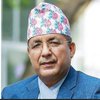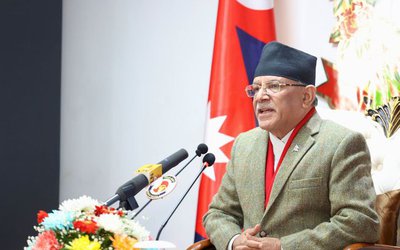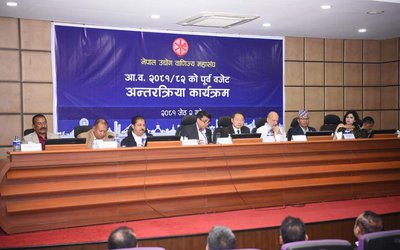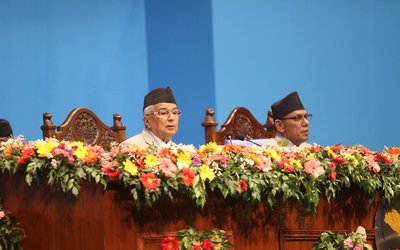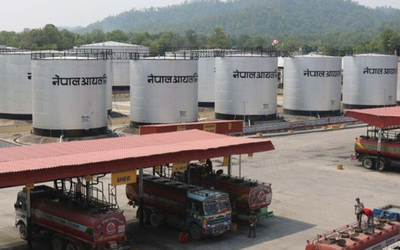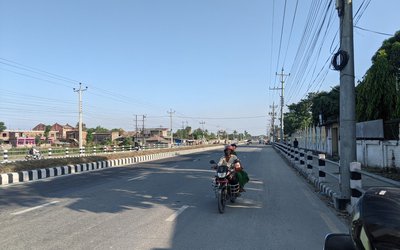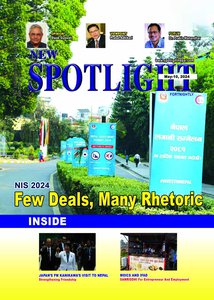
Existing realities
No country in the world was well prepared to address the impacts of COVID-19 and Nepal was no exception. In Nepali societies, COVID-19 has created serious health crises; increased social inequalities, exclusion, and discrimination; exacerbated adverse long-term socio-economic impacts; and threatened social protection. With the suspension of businesses, people lost their jobs, some temporarily other permanently. Lockdown has seriously challenged the tourism, industry, trade, agriculture, remittance, investment and infrastructure development sectors. People engaged in the informal sector have lost their jobs, are submerged in debt and have fallen intoa vicious circle of poverty. Federal, provincial and local governments have been activating their mechanisms to respond to the crisis and take strategic decisions to improve health systems, lessen adverse socio-economic impacts,and scale up social protection but how successful they are depending upon the decisions and actions these governments take in the coming days.
Impacts of COVID-19 on social protection
Families that are already below the poverty line, fall in low-income groups,and returnees from abroad have been hardest hit by the suspension of economic activities.It is estimated that more than 4.3 million Nepali people who are working abroad, mostly in Middle Eastern countries,are now at risk of losing their jobs. Millions of migrant workers are returning home empty-handed, which means more mouths to feed but fewer resources with which to do so, has further jeopardized their families’ lives and livelihoods. Landless people are at risk of infection as they don't have proper shelters, adequate water or enough space to maintain social distancing. COVID-19 has further destabilized already weak social protections measures. A UNDP study (2020) found that 56.6% of the total population in Nepal have no access to either social protection or labour programs. People are worried about they will cope now and about the insecurity of their futures.A World Vision Nepal study (2020) noted that 48.3% of families have taken loans from private money lenders and that 28.4% have reduced their food consumption to cope with COVID-19.
In Nepali society, discrimination in terms of caste, class, gender, and the like is widespread and COVID-19 has only served to increase its extent and magnitude. COVID-19 has degraded the societal fabric as well as people’s values, wisdom and morale, thereby increasing risks and vulnerabilities among vulnerable people like children, persons with disabilities, adolescent girls, pregnant and lactating mothers, single women, senior citizens and minorities. The risks of domestic and gender-based violence, including attempts at rape, allegations of witchcraft, and polygamy; family disputes and suicidal tendencies due to the lack of financial resources;and mental health problems are reported to have decreased due to the distress associated with COVID-19. Nervous breakdowns, socio-mental trauma and attempts at mass-murder are reportedly increasing.
Family, kinship, clan, and community resources are the ‘jewels of social networks’ and can impact capacity to cope with crises. But COVID-19 severely damaged the social harmony required to safeguard social protection and secure livelihoods. The impact of COVID-19, along with rampant poverty and limited economic opportunities, have all collectively challenged resource-poor families, threatening their very survival. COVID-19 has reinforced social inequalities and destabilized social coherence. In many communities, local people are concerned that new entrants, including returnees from abroad, are carriers of the virus. People have even locked doors to keep out the family members of virus-infected people and have erected fences to restrict their mobility. A culture of mistrust is expanding: people are reluctant to share water, buy vegetables and milk from infected families and use communal resources. Social and religious relationships have been severed and people are refusing to get involved in social work. A state of social rejection is growing and as it grows, it is weakening social protection. Though baseless, allegations that Muslims are corona virus carriers are spreading a kind of Islamophobia in society. They are even charged for spitting on currency notes and fruits and vegetables and for spreading the virus to people who observe other religions. In this way, the pandemic is further marginalizing ethnic minorities and increasing stigma and discrimination in society. The pandemic is also creating a social divide and promoting exploitation and suppression by criminalizing the poor and powerless.
Nepal's Fifteenth Periodic Plan (2019/20-2023/24) projects that the nation’s economic growth rate will bean average of 9.6%and its agricultural growth 5.6% per year over the next five years. The service sector was expected to grow 9.9%annually. However, this pandemic is likely to make it impossible to meet these targets.COVID-19-related impacts are expected to reduce Nepal's overall economic growth from targeted 8.5% to just 2.27% this fiscal year (CBS, 2019) because Nepal’s economy is largely dependent on remittance (30%), tourism (8%), and agriculture (26%), all of which will be negatively impact by the pandemic.
More than 95% small enterprises are nearly closed due to the lockdown and shortage of raw materials. Both wholesalers and retailers have been affected. People are facing financial constraints due to the closure of their businesses. The price of daily commodities has increased and their supply has been impeded due to the fear that their import from India will be interrupted. It is expected that both revenue collection and government spending will decline this fiscal year. Government stimuli will be insufficient to prevent economic crises, and its inability to stave off this decline will affect Nepal's target to reduce poverty. Fragmented social protection schemes such as health insurance programs, social security funds, social security allowances, and government employee health insurance are also creating problems. As the majority of workers earn in come in the informal economic sector, they have no access in employment-based social protection programs. As more women than men work in low-paying, insecure and informal jobs, COVID-19 has had a more adverse impact on women than men, thereby adding to their level of risk and vulnerability.
A UNDP study (2020) revealed that three in every five employees of both formal and informal micro, small and medium enterprises in Nepal have lost their jobs. Employment related to tourism, trade and foreign jobs have been badly hit. Remittance, which accounts for almost 30% of the GDP, has been very badly impacted. This source of income, a financial lifeline for many poor families, will decline 15% to 20% this year (CBS 2019). Nepal Rastra Bank reports that the remittance income of Nepalis working abroad was NPR 879.3 billion during 2018/19 and that the ratio of remittance inflows to GDP increased from 9.7% in 1999/2000 to 25.4% in 2018/19. COVID-19 has pushed poor families closer to and even below the poverty line because the agricultural and business sectors will not be self-reliant as remittances will decline sharply and income from trade and tourism will be significantly lower than expected. The decline will make it hard for Nepal to graduate to a developing country from a least developed country and ultimately move up to a middle-income country.
COVID-19 has widened socio-economic inequalities among families, increased exclusion and shrunk social safety nets. The pandemic has hit the 80% of workers who work in the informal economy (ILO 2018) very hard as they have limited or no access to social safety nets. It is likely that food insecurity will increase in some of the poverty-stricken areas of Karnali Province, Province 2, and Sudurpachhim Province. A WFP survey projected that yields of wheat and other winter crops would be low.In many villages, cooperatives are non-functional due to the increase in bad debt, and savings-and-credit groups are non-functional because members started to withdraw their shares when they had no other way to sustain their families.The COVID-related shortage in agriculture in puts such as seeds, fertilizers, and irrigation facilities is further expected to lower agriculture yields this year. The grain allocated for seed has been consumed and people have no surplus seeds to sow.
What are the next steps?
In order to mitigate the socio-economic impacts of COVID-19 on poor and marginalized families, there is an urgent need to design along-term recovery program. Though the government has offered a‘relief package’ to the poor, rescheduled loans for businesses, and exempted people from paying electricity bills, these provisions are inadequate and short-term.To reduce pain and suffering, short-term employment in the industry, trade, tourism, education and health sectors should be arranged for returnees, migrant workers, and unemployed youths by mobilizing Prime Minister’s Employment Fund. A stimulus and socio-economic recovery package and strategy need to be developed with the poor and vulnerable at the centre for overall crisis management. Coordination among governments, the private sector, civil society and international development partners needs to be strengthened to promote synergistic idea- and resource-sharing. The pandemic response and disease surveillance should be fostered to ensure that children and women are protected from COVID-19 impacts.There is an urgent need to mobilize youths in order to boost the economy and achieve recovery, as well as to manage soft loans, subsidies and grants to women-led small enterprises to promote their economic resilience. Cooperatives, the financial sector and development partners need to be mobilized to support the diversification of livelihood. Social security-based programs like direct cash transfers, cash-for-work, business grants, relief packages to farmers, and insurance coverage are other areas of focus to look into.
Social security funds should be invested in both short- and long-term recovery programs for the welfare of returnee workers. There is a pressing need to commission a post-pandemic damage and needs assessment to formulate recovery plans and programs, develop a social security package for COVID-19-affected people, strengthen guarantees of economic and social rights and social protection, and strengthen shock-responsive social protection initiatives.There is a need to focus on mitigating disasters and climate change impacts as well as on promoting livelihood assets so that people can cope with and recover from the external shocks induced by COVID-19.
Without delay, the government need to enforce existing social protection programs such as grants for children and cash transfers for senior citizens, people with disabilities, ethnic minorities, and single women; execute a Karnali employment program;run poverty reduction programs, public works, and micro-insurance initiatives very carefully; and provide financial support to unreached sections. Before this, there is a need to identify hot spots of disease outbreak and find food-insecure pockets and most-at-risk local governments through mapping. Programs to strengthen social solidarity, harmony, and neighborhood action are simultaneously required at the community, ward and local government levels. A real-time evaluation of COVID-19 preparedness and response is needed as Nepal is close to ending its lockdown period and initial response and is moving forward to identify good initiatives, existing gaps, key learning and a way forward. The effectiveness of a recovery program is based on how well all three tiers of government are able to manage financial resources, foster partnerships with relevant agencies, establish good coordination and implement an effective monitoring mechanism for the best use of resources.
(Dr. Gautam is associated with National Disaster Risk Reduction Centre, NDRC Nepal, as Senior Research Fellow. He is also Adjunct Fellow at HARDI/Western Sydney University. He often works as 'Independent Evaluator and Consultant'. He can be reached through drrgautam@gmail.com)
- Renewable Energy-Sector Policy Initiatives And UNDP’s Role In The Pacific Region: The Path Ahead
- Mar 04, 2024
- Operationalization Of Nepal’s National Adaptation Plan: Institutionalizing A Monitoring, Review, And Reporting System Is Crucial
- Jan 09, 2024
- Building A Pacific Region Resilient To Climate Change: A Seven Step Approach Is Urgently Required
- Jan 04, 2024
- The “Safe School” Campaign: Is Nepal moving In The Right Direction?
- Sep 12, 2022
- Nepal’s DRRM Policy Landscape: Well On The Way To Making Nepal Ready And Able To Respond To Disasters
- Aug 22, 2022
